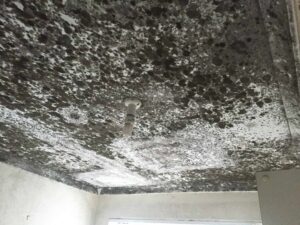Mold Removal Process Chomedey
Mold has health implications aside from the fact that it is unsightly and unclean. Mold spores that land in a wet or damp environment can begin to grow, producing allergens, irritants, and potentially toxic substances that affect indoor air quality and occupant health. Mold exposure in the home can cause or worsen pre-existing health conditions in homeowners. Mold reproduces by releasing reproductive spores into the atmosphere. Mold can spread and grow anywhere in the home as long as there is moisture and oxygen. Spores are invisible to the naked eye. Mold can grow on drywall, insulation, tile, fabrics, and wood, among other things. Mold is important to remember for two reasons:
- Avoid it by doing things correctly the first time.
- If you do face mold, take care of it right away.

Mold removal in Chomedey
The steps below serve as a basic process for quickly remediating mold problems and can be adapted to fit within your company’s policy. Having your warranty team follow a mold cleanup and remediation process will take care of the latter.
Discover the role of moisture in mold growth
Assessing mold growth entails more than just inspecting what’s visible on the walls or in a corner. Mold can be an unseen intruder, growing behind and around what you see at first. In Chomedey, such devious behavior necessitates inquisitive thinking.
To begin, recognize that all mold growth is caused by a water or moisture problem. Second, become a moisture master by understanding where moisture comes from and how it enters the home. The ultimate goal of these two steps is for warranty representatives to identify a moisture source and use its location to aid in the identification of all mold growth, not just what is immediately visible.
Create a mold remediation plan and document the mold problem
Document the mold situation with writing, photos, and video before beginning mold cleanup and removal in your Chomedey home. The documentation will be used by the warranty team supervisor to create a remediation plan, which will typically answer questions such as when work will begin, when work will be completed, who will be performing the remediation, any testing that should be done, and whether homeowners will be temporarily relocated. In the long run, the documentation can help your company manage liability or point to large trends in mold growth.
Determine the extent of mold contamination in your Chomedey home
Mold does not always grow in the same place, so you must determine how much contamination you are dealing with. The extent of the contamination will influence how you approach mold removal and cleanup. Mold removal aims to clean up mold that has grown within the home while avoiding exposing homeowners to large amounts of mold.
Clean up mold contamination
Mold removal and remediation will always entail cleaning up existing mold while avoiding exposure to oneself and others, as well as preventing new growth by addressing the moisture source. Determine if you’re working in an area up to 30 square feet, roughly the size of a full sheet of drywall, based on your contamination area calculation. If this is the case, you will be following the guidelines for remediation levels 1 and 2. Level 1 remediation is used for small, isolated areas of mold up to 10 square feet in size, while Level 2 remediation covers square footage ranging from 10 to 30 square feet in size.
The cleanup procedure for Level 1 and Level 2 mold remediation is the same and consists of the following steps:
Resolve the water issue: This will help to prevent the growth of new mold spores.
Seal off the contaminated area: For both levels, close all doors and windows between the contaminated area and the rest of the house. Cover all doorways and other openings with 6 mil polyethylene sheeting for Level 2 remediation. Duct tape all seams of the sheeting and slip openings in the sheeting to enter the contaminated area.
Eliminate dust: Mist the contaminated areas to accomplish this.
Remove all materials: Remove any wet or moldy porous materials. If you’re unsure about which materials to remove, consult with our supervisor.
Sort materials into plastic bags: All wet and moldy materials should be discarded in plastic bags at least 6 mils thick, double-bagged, and tied closed. After wiping the outside of the bags with a damp cloth and detergent solution before leaving the contamination area, the bags can be disposed of as regular trash.
Clean: Moldy nonporous materials and wood surfaces must be cleaned. Clean all moldy surfaces with a wire brush before wiping the area down with disposable wipes. To dispose of wipes as regular trash, place them in 6 mil polyethylene bags, double-bag them, and tie them closed. Finally, scrub all moldy surfaces with a damp cloth and detergent solution until all mold is removed, then rinse with clean water. Clean up the affected area and leave. At this point, the Level 1 process differs from the Level 2 process. Clean with a damp cloth and/or a detergent solution for Level 1. Level 2 necessitates vacuuming all surfaces with a HEPA vacuum, followed by cleaning all surfaces with a damp cloth and/or mop and detergent solution. Wipes should be discarded in the manner described above.
Check for visibility: All areas must be clearly free of contamination and debris; no dust or dirt means no mold.
Just because the mold is gone and there is no dirt or dust on the floor doesn’t mean you’re finished. The final step is to determine whether or not your cleanup efforts were successful. While the final step is a matter of judgement, there are some options and guidelines to consider if you are living in Chomedey.
- The moisture issue has been resolved. Returning to the home soon after remediation should reveal no signs of recurring water damage.
- There is no evidence of visible mold, mold-damaged materials, or moldy odors.
- Homeowners should be able to occupy or re-occupy their home without experiencing physical symptoms or aggravating health problems.
Depending on your company and the specifics of a mold problem, an environmental testing company may perform additional testing after the clean up to ensure that all mold has been removed. The key to preventing mold is to implement a comprehensive moisture management strategy. By doing it correctly the first time, potential liability and health issues from mold can be greatly reduced. Clean up must be immediate and thorough, following a process similar to the steps outlined above. The primary failure in response to homeowner complaints is simply that builders do not respond quickly enough, or with the emphasis that the issue is potentially serious.
